Alfa Romeo Junior vs Citroen C4 – Differences & prices compared
Compare performance, boot capacity, efficiency and price at a glance.
Find out which car is the better choice for you – Alfa Romeo Junior or Citroen C4?
In the ever-evolving automotive landscape, the comparison between the Alfa Romeo Junior and Citroen C4 is an exciting exploration of style, performance, and technology. These two compact SUVs present unique perspectives on how to blend innovation with driving enjoyment. Let's dive into the technical aspects that define these models.
Design and Dimensions
Starting with aesthetics, the Alfa Romeo Junior exudes an iconic Italian flair with its sporty lines and aggressive styling. It measures 4173 mm in length, 1781 mm in width, and has a height of 1533 mm. By contrast, the Citroen C4 offers a more robust presence, stretching up to 4580 mm in length and 1834 mm in width, standing 1525 mm tall. The C4's more extensive dimensions translate to a slightly more spacious cabin, making it an attractive option for families or those needing more interior comfort.
Powertrain Options
The Junior stands out with an impressive range of powertrains including electric and petrol hybrid options, producing up to 280 HP with a torque of 345 Nm. It offers both front-wheel and all-wheel drive configurations, allowing for versatile performance across different driving conditions. Its electric variant boasts a maximum range of up to 410 km and a battery capacity of 51 kWh, catering to environmentally conscious drivers.
The Citroen C4 offers a variety of engines as well, though it sports a slightly less potent lineup with a maximum output of 156 HP and torque reaching 270 Nm. Its electric model, with a range of 427 km, is highly competitive, with a 51 kWh battery capacity ensuring a robust driving experience. Additionally, both vehicles come with automatic transmissions, enhancing driving comfort and reducing the hassle of gear shifts.
Fuel Efficiency and Performance
When it comes to fuel consumption, the Junior's figures are commendable with an average of 4.5 L/100km for petrol variants and 15.2 kWh/100km for electric models. This efficiency is complemented by its swift acceleration times, where some models reach 0-100 km/h in just 5.9 seconds, catering to enthusiasts seeking a dynamic drive.
While the Citroen C4 slightly lags in efficiency with an average consumption of 4.8 L/100km, it maintains competitive performance with 0-100 km/h times as low as 9.7 seconds. The electric C4 also presents an efficient consumption rate of 14.5 kWh/100km, making it a suitable alternative for those considering an eco-friendly vehicle.
Interior and Technology
Both the Alfa Romeo Junior and Citroen C4 emphasize modern interiors packed with technology. The Junior boasts a contemporary design with a focus on driver engagement and quality materials. It comfortably seats five, employing advanced infotainment systems and driver assistance features.
In contrast, the Citroen C4 leans heavily into comfort and practicality. The spacious interior includes a large trunk capacity of up to 510 L, accommodating grocery trips or weekend getaways effortlessly. Its tech integrations are user-friendly, ensuring a connected experience for passengers, alongside features that enhance overall ride comfort.
Conclusion: The Verdict
Ultimately, choosing between the Alfa Romeo Junior and the Citroen C4 boils down to personal preferences. The Junior captivates those seeking sporty performance with a flair for stylish design, while the C4 appeals to practicality and comfort, making it a family-friendly choice. Each model presents innovative technologies that cater to modern drivers, affirming their positions as contenders in the ever-competitive compact SUV market.
Here’s where it gets real: The technical differences in detail
Costs and Efficiency: Looking at overall running costs, both models reveal some interesting differences in everyday economy.
Citroen C4 has a evident advantage in terms of price – it starts at 20600 £, while the Alfa Romeo Junior costs 25700 £. That’s a price difference of around 5109 £.
Fuel consumption also shows a difference: the Citroen C4 manages with 4.70 L and is therefore hardly perceptible more efficient than the Alfa Romeo Junior with 4.80 L. The difference is about 0.10 L per 100 km.
In terms of energy consumption, the advantage goes to the Citroen C4: with 14.50 kWh per 100 km, it’s slight more efficient than the Alfa Romeo Junior with 15.10 kWh. That’s a difference of about 0.60 kWh.
As for range, the Citroen C4 performs hardly perceptible better – achieving up to 427 km, about 17 km more than the Alfa Romeo Junior.
Engine and Performance: Power, torque and acceleration are the classic benchmarks for car enthusiasts – and here, some clear differences start to show.
When it comes to engine power, the Alfa Romeo Junior has a significantly edge – offering 280 HP compared to 156 HP. That’s roughly 124 HP more horsepower.
In acceleration from 0 to 100 km/h, the Alfa Romeo Junior is noticeable quicker – completing the sprint in 5.90 s, while the Citroen C4 takes 8 s. That’s about 2.10 s faster.
In terms of top speed, the Citroen C4 performs minimal better – reaching 210 km/h, while the Alfa Romeo Junior tops out at 206 km/h. The difference is around 4 km/h.
There’s also a difference in torque: the Alfa Romeo Junior pulls clearly perceptible stronger with 345 Nm compared to 270 Nm. That’s about 75 Nm difference.
Space and Everyday Use: Whether family car or daily driver – which one offers more room, flexibility and comfort?
Both vehicles offer seating for 5 people.
In curb weight, the Citroen C4 is barely noticeable lighter – 1341 kg compared to 1380 kg. The difference is around 39 kg.
In terms of boot space, the Citroen C4 offers slightly more room – 510 L compared to 415 L. That’s a difference of about 95 L.
In maximum load capacity, the Citroen C4 performs minimal better – up to 1360 L, which is about 80 L more than the Alfa Romeo Junior.
When it comes to payload, Alfa Romeo Junior minimal takes the win – 420 kg compared to 406 kg. That’s a difference of about 14 kg.
Our conclusion: The Alfa Romeo Junior proves to be wins the duel decisively and thus becomes our DriveDuel Champion!
Overall, Alfa Romeo Junior is the better all-rounder in this comparison.
Alfa Romeo Junior
The Alfa Romeo Junior captures the essence of Italian design with its sleek lines and compact dimensions, making it an icon of elegance and performance. With a spirited driving experience and a charming retro aesthetic, it appeals to enthusiasts and casual drivers alike. This delightful car embodies the brand's rich heritage while remaining a fun and engaging option for those seeking a unique automotive experience.
details @ media.stellantis.com
@ media.stellantis.com
 @ media.stellantis.com
@ media.stellantis.com
 @ media.stellantis.com
@ media.stellantis.com
Citroen C4
The Citroen C4 combines contemporary style with a comfortable driving experience, making it a standout choice in the compact car segment. Its sleek silhouette is complemented by a range of thoughtful interior features, providing both driver and passengers with a pleasant journey. With modern technology seamlessly integrated into its design, the C4 offers an efficient performance that caters to urban and rural environments alike.
details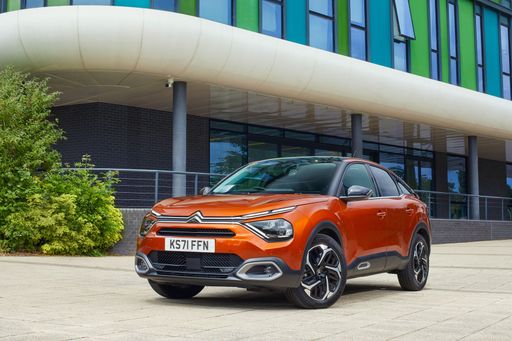 @ media.stellantis.com
@ media.stellantis.com
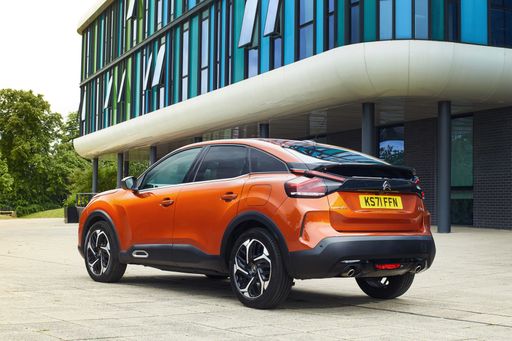 @ media.stellantis.com
@ media.stellantis.com
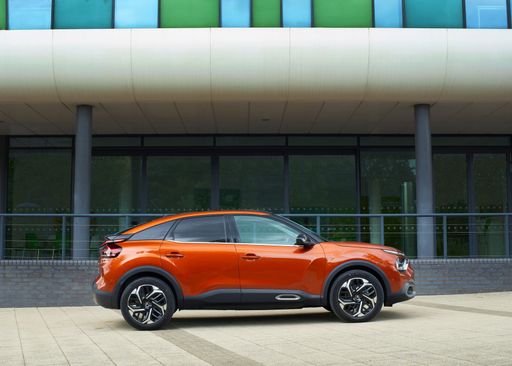 @ media.stellantis.com
@ media.stellantis.com
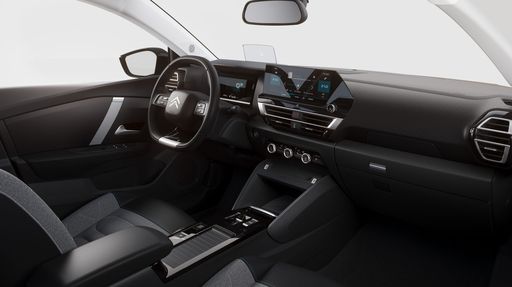 @ media.stellantis.com
@ media.stellantis.com
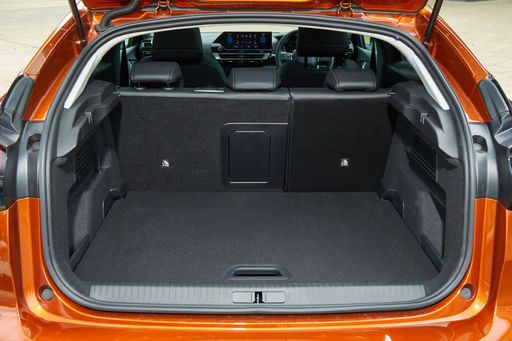 @ media.stellantis.com
@ media.stellantis.com

|

|
|
|
|
Costs and Consumption |
|
|---|---|
|
Price
25700 - 41600 £
|
Price
20600 - 32000 £
|
|
Consumption L/100km
4.8 - 5.4 L
|
Consumption L/100km
4.7 - 5.9 L
|
|
Consumption kWh/100km
15.1 - 17.5 kWh
|
Consumption kWh/100km
14.5 - 15.3 kWh
|
|
Electric Range
344 - 410 km
|
Electric Range
354 - 427 km
|
|
Battery Capacity
0.4 - 51 kWh
|
Battery Capacity
46 - 51 kWh
|
|
co2
0 - 119 g/km
|
co2
0 - 134 g/km
|
|
Fuel tank capacity
44 - 45 L
|
Fuel tank capacity
44 - 50 L
|
Dimensions and Body |
|
|---|---|
|
Body Type
SUV
|
Body Type
SUV
|
|
Seats
5
|
Seats
5
|
|
Doors
5
|
Doors
4 - 5
|
|
Curb weight
1380 - 1689 kg
|
Curb weight
1341 - 1659 kg
|
|
Trunk capacity
340 - 415 L
|
Trunk capacity
380 - 510 L
|
|
Length
4173 mm
|
Length
4350 - 4580 mm
|
|
Width
1781 mm
|
Width
1800 - 1834 mm
|
|
Height
1505 - 1538 mm
|
Height
1520 - 1525 mm
|
|
Max trunk capacity
1205 - 1280 L
|
Max trunk capacity
1250 - 1360 L
|
|
Payload
390 - 420 kg
|
Payload
381 - 406 kg
|
Engine and Performance |
|
|---|---|
|
Engine Type
Electric, Petrol MHEV
|
Engine Type
Petrol, Electric, Petrol MHEV
|
|
Transmission
Automatic
|
Transmission
Automatic
|
|
Transmission Detail
Dual-Clutch Automatic, Reduction Gearbox
|
Transmission Detail
Automatic Gearbox, Dual-Clutch Automatic, Reduction Gearbox
|
|
Drive Type
Front-Wheel Drive, All-Wheel Drive
|
Drive Type
Front-Wheel Drive
|
|
Power HP
136 - 280 HP
|
Power HP
110 - 156 HP
|
|
Acceleration 0-100km/h
5.9 - 9.1 s
|
Acceleration 0-100km/h
8 - 10.8 s
|
|
Max Speed
150 - 206 km/h
|
Max Speed
150 - 210 km/h
|
|
Torque
230 - 345 Nm
|
Torque
205 - 270 Nm
|
|
Number of Cylinders
3
|
Number of Cylinders
3
|
|
Power kW
100 - 207 kW
|
Power kW
81 - 115 kW
|
|
Engine capacity
1199 cm3
|
Engine capacity
1199 cm3
|
General |
|
|---|---|
|
Model Year
2024 - 2025
|
Model Year
2025
|
|
CO2 Efficiency Class
A, C, D
|
CO2 Efficiency Class
D, A, C
|
|
Brand
Alfa Romeo
|
Brand
Citroen
|
What drive types are available for the Alfa Romeo Junior?
Available configurations include Front-Wheel Drive or All-Wheel Drive.
The prices and data displayed are estimates based on German list prices and may vary by country. This information is not legally binding.
